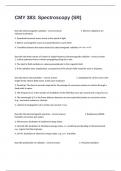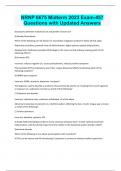Exam (elaborations)
CMY 383: Spectroscopy (SR) Actual Questions And Correct Detailed Answers.
- Course
- Institution
Describe electromagnetic radiation - correct answer 1. Electron radiations are released as photons 2. Quantized harmonic waves travel at the speed of light 3. Electric and magnetic waves are perpendicular to each other 4. Transition between the states induc...
[Show more]






